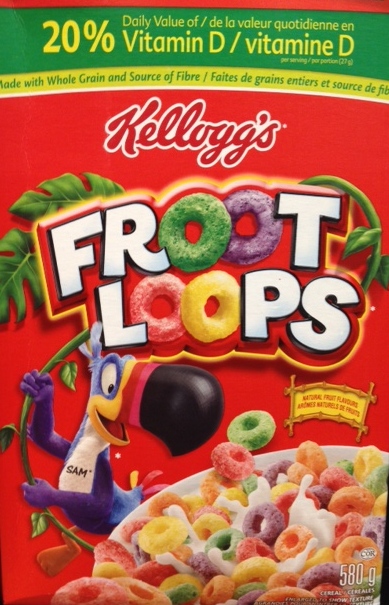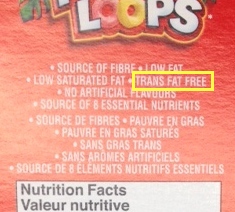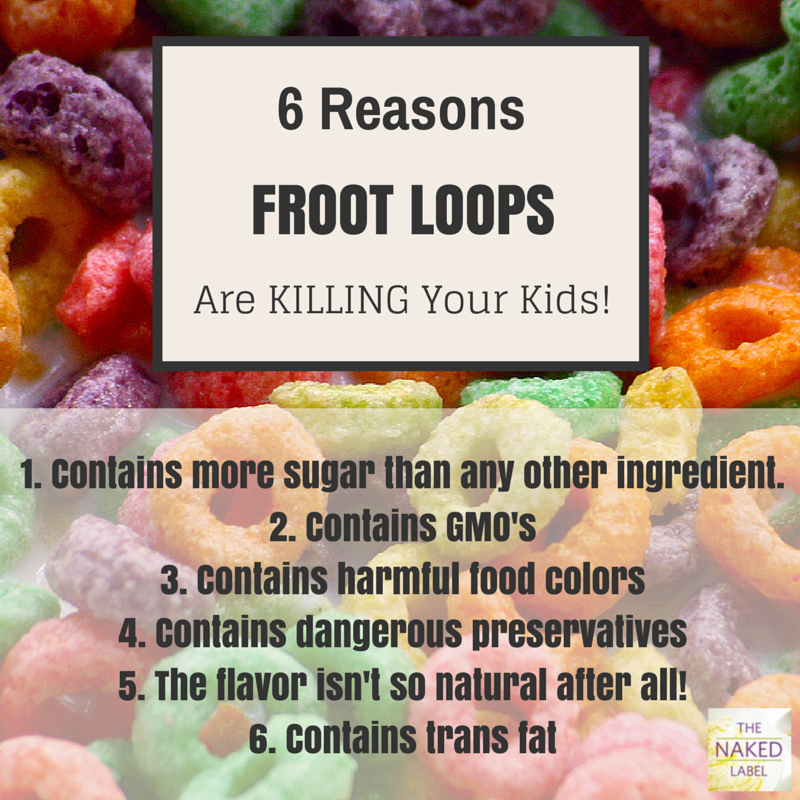 Personally, I’m not a big cereal eater. My parents didn’t feed it to me much as a kid and as a result it’s not a habit I have carried into adulthood. So when I ventured down the cereal aisle to see what looked good naked and what didn’t, no cereal blew me away more than Froot Loops. I actually remember laughing out loud when I read the package. I think it was more a laugh of horror. I could not believe that a company in good conscience would actually make this product for children. The dishonesty in their labelling and marketing blew me away. On top of that, the combination of ingredients is appalling.
Personally, I’m not a big cereal eater. My parents didn’t feed it to me much as a kid and as a result it’s not a habit I have carried into adulthood. So when I ventured down the cereal aisle to see what looked good naked and what didn’t, no cereal blew me away more than Froot Loops. I actually remember laughing out loud when I read the package. I think it was more a laugh of horror. I could not believe that a company in good conscience would actually make this product for children. The dishonesty in their labelling and marketing blew me away. On top of that, the combination of ingredients is appalling.
Let’s undress Froot Loops to see why it looks so bad naked.
One of the things that really gets my blood boiling is when companies purposely mislead consumers trying to trick us into thinking their product is healthier than it really is. When I looked on the Kellogg’s website to see what they said about this product I found this description “A colourful breakfast cereal with incredible taste and aroma made with corn, wheat, whole grain oats and natural fruit flavouring.”.
It seems like they just pulled out anything from their ingredient list that sounds healthy and conveniently forgot to mention the rest of them! In my opinion, this is health washing at its finest. If I were to right a description about this product I would say it is a sugar laden cereal with, genetically modified grains, potentially harmful colours, unhealthy preservatives, and a concoction of flavours created in a lab. Does this sound appetizing? Does it sound like something you would want to feed your kids? Probably not. I’m guessing Kellogg isn’t going to hire me as their marketing manager anytime soon, haha.
Let’s take a closer looks at what’s inside the Froot Loops box.
Kellogg’s Froot Loops Ingredients
Ingredients: Sugar, whole grain corn flour, wheat flour, whole grain oat flour, oat hull fibre, corn bran, hydrogenated coconut and vegetable oil, salt, colour, natural fruit flavouring, BHT, iron, niacinamide, zinc oxide, thiamine hydrochloride, d-calcium pantothenate, cholecalciferol, pyridoxine hydrochloride, folic acid.
6 Reasons I Avoid Froot Loops Cereal
Reason #1: There is more refined white sugar than any other ingredient!
Wow, I could not believe my eyes when I read the ingredient list. The first ingredient in Froot Loops is sugar. That means there is more sugar in this product than anything else. In fact there is 12g in just 1/2 a cup! This is outrageous.
A study conducted by Yale University indicated that children ages 5 to 12 on average ate 2 to 3 times this amount in a single sitting. This means these kids could be getting 24-36g of sugar in their breakfast cereal. The World Health Organization in 2014 suggested the DAILY sugar intake for kids could be as low as 12.5g. Clearly, there is too much sugar in Froot Loops!
One big problem with white sugar is that it is heavily processed and refined. It therefore provides large amounts of “empty calories”. This means that you are getting the calories without any of the beneficial vitamins and minerals that our body requires to function.
This excess in sugar is converted to fat in the body and is a major cause of obesity. It also spikes our blood sugar and can lead to many undesirable health implications like high cholesterol, diabetes, and heart disease.
According to the Centers for Disease Control and Prevention (CDC). Childhood obesity has more than doubled in children and quadrupled in adolescents in the past 30 years. In fact, in 2012, more than one third of children and adolescents were overweight or obese. This number continues to rise.
The problem is that obesity is very dangerous. It significantly increases their risk of developing heart disease, high cholesterol, high blood pressure, stroke, and even cancer.
White sugar is not nutritious, it is not a healthy food for adults or children, and it should be avoided as much as possible. It certainly should not be consumed on a daily basis and it is not part of a complete breakfast!
Reason #2: This product likely contains genetically modified foods
Since we still haven’t required companies to label their products in a way that informs consumers about whether or not their product contains genetically modified ingredients, its hard to be 100% sure if this product contains genetically modified ingredients.
However, according to the USDA approximately 93% of corn acreage in the USA was genetically modified. This is the type of corn used by food processors to make things like corn flour (found in your froot loops).
In addition, the USDA stated that approximately 95% of sugar beets (used to make sugar) are genetically modified (USDA, 2013). Sugar beets are one of the main two crops used to produce the large amount of sugar we consume in North America. 55% of sugar is made from sugar beets.
It doesn’t stop there. The product lists vegetable oil as an ingredient. Approximately 90% of American oilseed production comes from soybeans which the USDA indicates is almost certainly genetically engineered. If they haven’t used soybean oil then it’s highly likely they have used cottonseed, sunflower seed, canola, rapseed, or peanut oil. Many of these oils (especially canola, cottonseed, and corn oil come from genetically engineered crops).
As you can see, there is a VERY high probability that this cereal contains genetically modified ingredients.
So why does this matter? One of the reasons this is important is that according to the Environmental Working Group (EWG) growing genetically modified plants requires the use of stronger chemicals (herbicides, pesticides, etc). It also requires that we use A LOT MORE of these harmful chemicals. These chemicals can end up in your cereal and could cause harm. Especially if they are consumed regularly.
In addition there are no conclusive studies done by independent scientific institutions proving cumulative and long term consumption of genetically modified crops to be safe. Companies who produce these seeds are not required to test for carcinogenicity, fetal harm, or other long term risks. That being said, there have been some studies conducted that concluded genetically modified foods could be harmful to our health. Genetically modified crops were only introduced in the 1990’s. Shockingly they now account for over 75% of the food supply according the the EWG.
The way I see it, since some studies suggest genetically modified foods could be harmful, and there are no studies proving they are safe for cumulative long term consumption, I AVOID THEM!
I don’t want to be the science experiment and I don’t think our kids should be either.
Reason 3: Artificial food color may cause hyperactivity, food allergies, and CANCER!
The National Cancer Institute indicated that between 1992 and 2007 childhood cancer rates increased by 9.4%. Unfortunately, this has not gone down in recent years. Furthermore hyperactivity and food allergies continue to rise as well. According to a detailed report published by the the Center For Science In The Public Interest there is significant research linking these artificial food dyes to cancer risk and many other harmful health conditions. Furthermore the University of Southampton conducted a study showing a link between hyperactivity and the consumption of food dyes when consumed with preservatives.
Clearly artificial food dyes do NOT belong in our kids cereal bowls.
Reason #4: This product contains BHT – a potentially harmful preservative
Butylated hydroxytoluene (BHT) is a preservative commonly found in cereal and many other processed foods. It helps to preserve the fats (so they don’t go rancid) as well as flavor, color, and odor. According to the European Food Safety Authority BHT has been shown to cause lung and liver tumors, developmental effects, and negatively impact the thyroid in animal studies.
In addition, the Centre for Science in The Public Interest and the Environmental Working Group both caution consumers against consuming this potentially harmful preservative.
While there are no conclusive studies showing concrete evidence that BHT is harmful to humans, there are also no studies concluding that it is safe. According to a wellness report by Berkley University, the Food and Drug Administration (FDA) categorizes BHT as GRAS (generally recognized as safe), however the report indicates that BHT never underwent a pre-market review and that subsequent reviews supported their general safety but concluded that “uncertainties exist, requiring that additional studies be conducted.”
Reason #5: Natural Flavours Are Not So Natural After All!
The reason I’m not a fan of these “natural flavors” is because they have been created in a lab and are masking the taste of a poor quality product.
Don’t let the term “natural” trick you into thinking it is healthy. The only difference between natural and artificial flavors is that natural flavors have been derived from plants or animals, whereas artificial flavors are not. However, no matter what the original source was, the chemical makeup of the final flavor could be similar because of the extensive amount of processing that goes into creating these flavors.
Companies often pay more for “natural” flavoring because there is a consumer perception that it is healthier. However, it’s not. In addition, many natural flavors contain many more ingredients than the artificial ones because they are more complicated to create. In some cases natural flavors could contain hundreds of chemicals. When you see the term “natural flavor” on an ingredient list you really have no idea what you are eating/drinking. Some of these chemicals could be derived from genetically modified ingredients, from allergenic foods, or could include additional preservatives and solvents.
Reason #6: Hydrogenated oils can cause heart disease!
The problem with our labelling laws is that they don’t require companies to be specific enough. For example, if a product is labelled as “hydrogenated vegetable oil” this could mean that the company uses either fully or partially hydrogenated oil. The difference between the two is very important.
Hydrogenation is a chemical process that turns a liquid fat into a solid fat. Companies use these fats because they are more shelf stable. If a liquid fat has been partially hydrogenated it means that it has created trans fats in the process. If a liquid fat is fully hydrogenated it means they have created a fully saturated fat. Therefore partially hydrogenated means trans fats and fully hydrogenated means saturated fat. Both of which have been heavily processed!
According to Health Canada, research has shown that trans fats from partially hydrogenated oils causes an increase in bad cholesterol, a decrease in good cholesterol, and cause heart disease.
THIS PART OF THE STORY WILL SHOCK YOU!
When a product like Froot Loops labels it’s product as “Trans Fat Free” which you will find on the side panel of the box, this doesn’t actually mean
 it’s trans fat free! It could be a bold-faced lie. Companies continue to justify this by saying they are adhering to proper labelling laws. Currently the law states that if a product contains less than 0.5g of trans fat per serving in the US or 0.2g of trans fat per serving in Canada, the product can be labelled trans fat free and the company can market the product as such. This drives me nuts!
it’s trans fat free! It could be a bold-faced lie. Companies continue to justify this by saying they are adhering to proper labelling laws. Currently the law states that if a product contains less than 0.5g of trans fat per serving in the US or 0.2g of trans fat per serving in Canada, the product can be labelled trans fat free and the company can market the product as such. This drives me nuts!
Since Froot Loops hasn’t indicated whether they are using fully or partially hydrogenated oils there is a good chance it is partially hydrogenated. Therefore, there is a high probability the product contains harmful trans fats. If this is true, they are able to market their product to us as being trans fat free because there is less trans fat per serving than our labelling laws recognize.
As a consumer should we get the right to know what’s really in our food? Especially when research shows such negative health implications? Personally, I avoid any product that lists “hydrogenated” on the ingredient list.
The Bottom Line
In my opinion, Froot Loops cereal does not look good naked. It seems that they have used fancy marketing techniques to convince us this product is healthier than it really is. In addition, the ingredients they use could cause many serious health implications for kids (and adults) including heart disease, diabetes, high cholesterol, high blood pressure, liver/lung tumors, stroke, hyperactivity, and even cancer.
Does this seem like something we should be feeding our kids for breakfast? Let me know your thoughts in the comment section below. I would love to hear from you!
Also please help spread the word by sharing this article. I’m on a mission to educate everyone about what is really in Kellogg’s Froot Loops so you can #VoteWithYourFork and buy foods that truly nourish you and your family. Thanks for reading!

Photo Credit: Froot Loops | Rosana Prada | Flikr (CC by 2.0)


